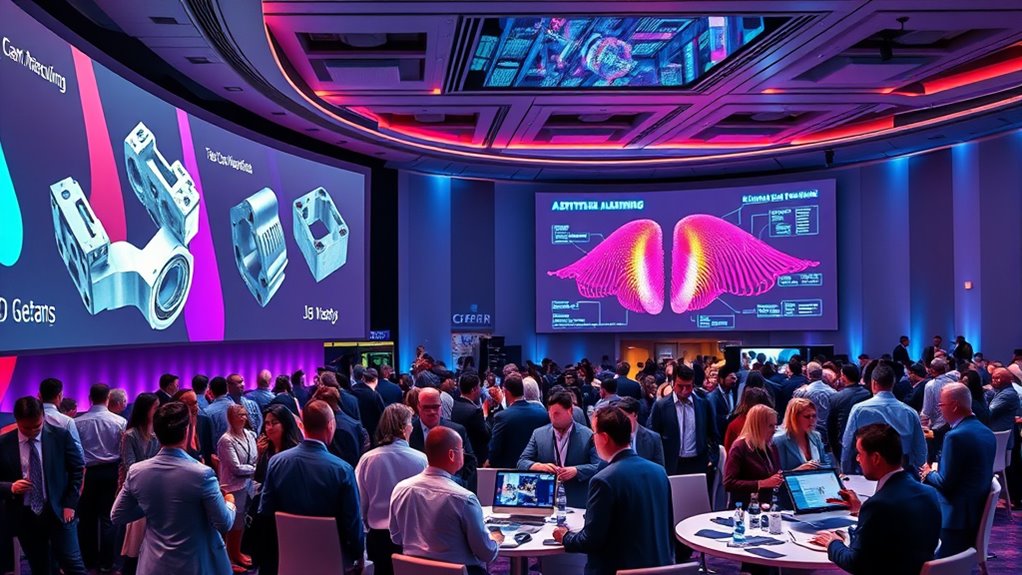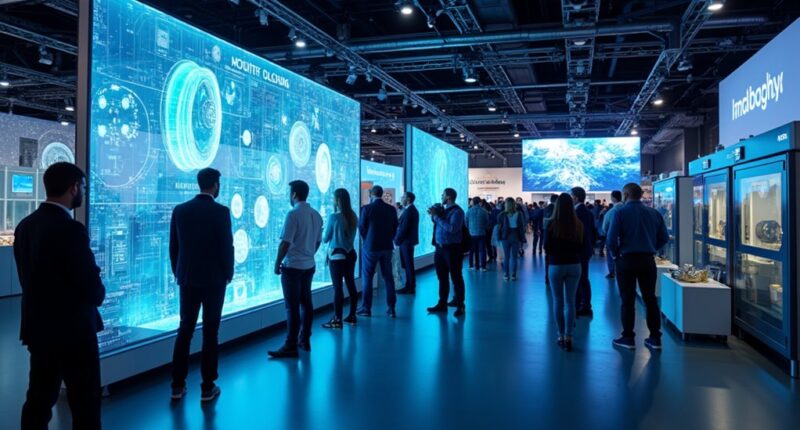At the 2026 Additive Manufacturing Meetup, you’ll see how machine learning is revolutionizing the industry. The event highlights breakthrough ML innovations that optimize production, improve quality, and reduce waste. You’ll explore sessions on defect detection, AI-driven design, and automation. With industry leaders, startups, and investors all present, it’s a key chance to understand the future of AM. Stay with us to discover more about these game-changing advancements.
Key Takeaways
- The conference emphasizes machine learning’s role in transforming additive manufacturing processes and workflows.
- Sessions highlight ML-driven defect detection, simulation, and design optimization techniques.
- Industry panels showcase breakthroughs in AI integration for automation and material discovery.
- Startups and innovators demonstrate ML-based solutions to attract investment and collaboration.
- The event features industry leaders discussing future trends and funding landscapes in ML-driven AM.

Are you ready to explore the future of additive manufacturing? The 2026 Additive Manufacturing Meetup promises to put you at the forefront of industry innovation, especially with its focus on machine learning breakthroughs. This in-person event, held at the Museum of Jewish Heritage in New York City from February 24 to 26, is designed to connect global AM stakeholders—startups, investors, and industry leaders—fostering direct discussions and collaborations that can accelerate technological advances.
One of the conference’s key highlights will be the spotlight on machine learning applications transforming AM processes. Expect to see sessions dedicated to how ML techniques optimize production, detect defects early, and enhance simulation-driven design. These innovations are essential for scaling additive manufacturing across various industries like aerospace, automotive, healthcare, and advanced materials. You’ll get a firsthand look at how AI and ML are not just supporting but actively driving production automation, material discovery, and business growth.
Discover how ML innovations are revolutionizing AM production, defect detection, and design across aerospace, healthcare, and beyond.
The agenda will likely feature technical panels and keynote addresses that explore integrating ML into the entire AM workflow—from initial design through post-processing. These discussions will showcase how machine learning models can improve accuracy, reduce waste, and speed up development cycles. Startup and innovation showcases will also emphasize ML-driven solutions, attracting attention from investors keen to fund next-generation AM technologies. If you’re involved in a startup or considering new projects, this event provides an ideal platform to demonstrate your innovations and gain visibility.
Attending the event means immersing yourself in a lively community of industry experts, engineers, analysts, and entrepreneurs. With no virtual options available, the focus remains on maximizing face-to-face interaction, so you can engage directly with thought leaders, tech pioneers, and potential partners. Sponsors and exhibitors will include top AM technology providers, financial institutions, and venture capital firms, giving you a thorough view of the current funding landscape and technological landscape.
Beyond the technical content, the event offers extensive networking opportunities through dedicated receptions and social events. These informal settings allow you to build relationships, exchange ideas, and explore collaborations that could shape your future projects. Whether you’re attending for insights into cutting-edge ML applications or seeking investment opportunities, the conference’s blend of educational sessions, industry panels, and networking makes it an essential annual gathering for the AM community.
Ultimately, the 2026 Additive Manufacturing Meetup positions machine learning at the core of industry evolution. The bond between industry leaders is your chance to witness breakthroughs firsthand, connect with key players, and stay ahead in this rapidly transforming field.
Frequently Asked Questions
What New Machine Learning Algorithms Were Showcased?
You saw new machine learning algorithms like Paved2Paradise’s sim2real pipelines, which boost transfer learning with less manual annotation, and neural networks trained on synthetic data achieving real-world accuracy. Reinforcement learning agents dynamically optimize print parameters, while anomaly detection algorithms flag deviations early. These innovations, combined with modular architectures and predictive models, enhance quality control, speed up materials discovery, and enable adaptive control—making additive manufacturing more efficient, reliable, and scalable.
How Will Breakthroughs Impact Manufacturing Costs?
You’ll see manufacturing costs drop considerably as breakthroughs in machine learning optimize processes, saving up to 20% in production expenses. These advancements enable predictive maintenance, reduce material waste, and streamline supply chains, making operations more efficient. With smarter algorithms, you can expect faster cycle times and better resource allocation, ultimately lowering long-term costs. Embracing these innovations gives you a competitive edge while making your manufacturing more cost-effective and sustainable.
Were Any Startups Featured for AI Innovations?
No, startups featuring AI innovations aren’t specifically highlighted at these events. However, these gatherings provide excellent opportunities for you to discover emerging AI-driven solutions in additive manufacturing. You can network with industry leaders, investors, and researchers to learn about new startups and partnerships. Attending these events can help you stay informed about the latest AI applications, innovations, and funding opportunities shaping the future of additive manufacturing.
What Are the Future Research Directions Discussed?
You’re about to uncover the future of additive manufacturing research. Researchers are exploring smarter AI algorithms that adapt in real time, pushing the boundaries of process precision. They’re also focusing on standardization to streamline global adoption, while developing advanced materials for extreme conditions. Collaborations between industry and academia aim to accelerate innovation, ensuring AM evolves into a fully integrated, predictive, and sustainable manufacturing ecosystem—transforming how you’ll create and innovate in the years ahead.
How Can Small Companies Adopt These Machine Learning Tools?
You can start by evaluating where machine learning adds value, like design or quality control, and then implement tools in phases. Attend industry events and leverage online courses to build your team’s skills. Partner with larger firms or research institutions for access to advanced technologies. Use data-driven decision making, integrate with existing machinery, and focus on scalable solutions. Collaborate with peers and explore funding opportunities to support your machine learning adoption journey.
Conclusion
As you leave the 2026 Additive Manufacturing Meetup, it’s clear that machine learning is revolutionizing the field faster than even Da Vinci’s sketches could predict. You’ve seen firsthand how smarter algorithms are pushing boundaries, making manufacturing more efficient and innovative. Remember, in this age of rapid technological leapfrogging, staying ahead means embracing these breakthroughs now—because, as they say, the future waits for no one. So, get ready to shape tomorrow today.









